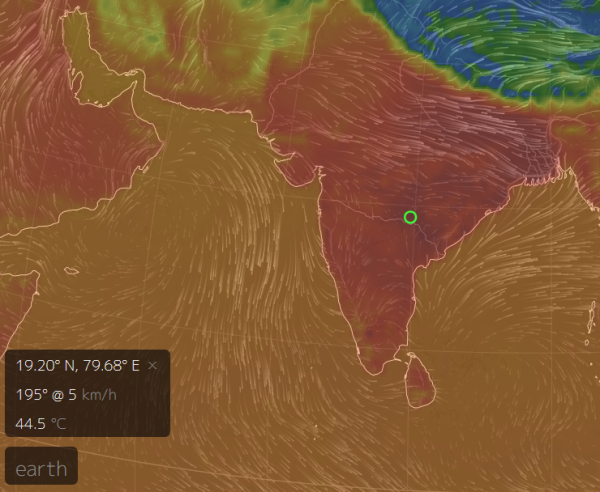"Climate
change is starting to impact India’s breadbasket. Record high
temperatures over the Gangetic Plain — India’s productive farming
region south of the Himalayas — are starting to take hold as a
result of a human-forced warming of the globe"
Heatwave Mass Casualties Strike India in April Amidst Severe Drought, Water Shortages
12
April, 2016
Loss
of water from snow melt in the Himalayas, increasing temperatures and
instances of drought over the food-producing plains, and a potential
endemic weakening of the annual monsoonal rains. These are all
climate change related impacts that appear to be settling in over
India as global temperatures consistently begin to hit levels higher
than 1 C above 1880s values. Impacts that are setting up conditions
for sustained and increasingly severe droughts and heatwaves.
****
Yesterday,
temperatures rocketed to 114.44 degrees Fahrenheit (or 45.8 degrees
Celsius) in Bhubaneshwar, the capital of Odisha, on the Indian east
coast.
It was the hottest April reading ever recorded for a region that
typically sees daily highs in the upper 90s this time of year. A
level of heat that’s excessive even for this typically warm region.
(Most
of India baked under a severe heatwave yesterday [April 11] as the
number of lives lost to heat stroke mounted and a water train was
dispatched to far-flung drought-stricken regions. Image source: Earth
Nullschool.)
Bhubaneshwar,
however, was just one of many locations experiencing temperatures
above 110 Degrees (F) yesterday. For a broad heatwave and a related
severe drought has sprawled over much of India throughout early April
— hitting a peak intensity for many locations this week. Heat
so intense that it had already resulted in the tragic loss of more
than 110 lives due to heat stroke by April 9th.
India’s
Two Year Drought
The
drought itself is an ongoing feature — one that has lasted now for
two years in many provinces as abnormally high temperatures and
reduced monsoonal rains have produced severe and widespread
impacts. In
total, 10 of India’s 29 states are now suffering under drought
conditions.
Some locations, like the Maharashtra town of Latur, east of
Mumbai, are experiencing water shortages are so severe that Indian
officials have dispatched a drought relief train — containing a
half a million liters of water — to provide aid. For hardest hit
areas, the situation is so dire that riots are now a risk — prompting
authorities to outlaw gatherings of more than 5 people near some
water distribution sites.
Maharashtra itself is experiencing some of the most severe
losses with
reports indicating that reservoirs there are at less than 5 percent
capacity.
Capacity for all reservoirs throughout India amounted
to just 29 percent by the end of March —
and the annual monsoonal rains are still at least two months way.
Overall
impacts are quite widespread. Ranchi, the capital of Jharkhand has
declared a water emergency. And the Ganges River is now so low that
it is unable to provide water to cool one of the largest coal-fired
electrical power stations in West Bengal — forcing
it to suspend operations.The
great river is dramatically shrunken — causing islands of mud to
emerge even as pollutants concentrate in its thinning thread. A
diminishing flow that India’s 1.3 billion people rely on for much
of their water. It’s a greater crisis so extreme that late last
month one of BBC’s India correspondents asked — is
this the worst water crisis India has ever faced?
Such
broad-ranging and long-lasting drought has hit India’s farmers
hard. Last
year, more than 3,500 farmers committed suicide after facing some of
the worst conditions ever to strike India.
This year, the situation is arguably even worse — forcing some
desperate regions to consider cloud seeding as a means of possible
drought alleviation.
Stronger
Monsoon for 2016? Or Will A Warming Globe Dim India’s Hopes For
Rain?
Reports
from India’s Meteorological Division have called for a normal to
above normal monsoon to provide replenishing rains this year.
However, monsoonal predictions over the past two years were overly
optimistic, which is cause for caution over last week’s forecast.
Overall,
the early extreme record heat and drought over India provides a
barrier to any influx of monsoonal moisture. In addition, El Nino
conditions — possibly hanging on in the Central Pacific through
June — may help to dull or delay monsoonal development even as a
predicted progression to La Nina later in the year provides some hope
for additional moisture during late Summer and Fall. A switch to
rains that may well be quite intense for some regions given the
unprecedented atmospheric moisture content as a result of record high
global temperatures.
Longer-term,
there are growing indications that
climate change is starting to impact India’s breadbasket.
Record high temperatures over the Gangetic Plain — India’s
productive farming region south of the Himalayas — are starting to
take hold as a result of a human-forced warming of the globe. A
condition that IPCC reports indicate could decimate (reduce by ten
percent) wheat, corn, soy and sorghum yields over the coming years.
So even as a shift to La Nina provides some hope for an alleviation
of India’s current drought woes later in 2016, the larger trend is
for an increasing prevalence of drought and extreme heat as a
reckless fossil fuel emission continues to force the globe to warm.
Links:




No comments:
Post a Comment
Note: only a member of this blog may post a comment.